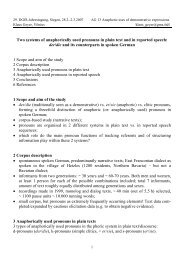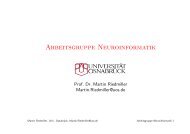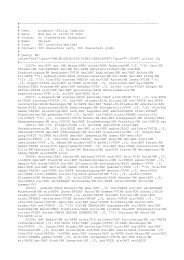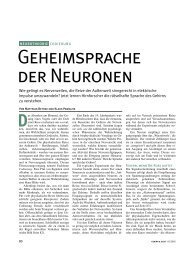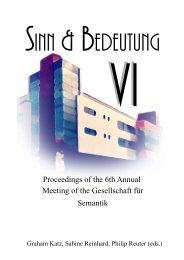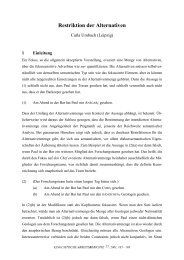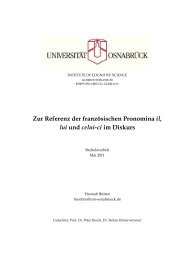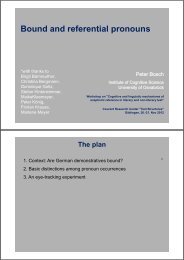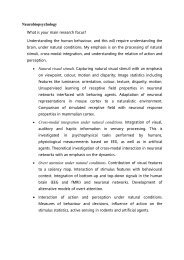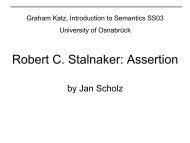Demonstrative Pronouns and Personal Pronouns. German der vs. er.
Demonstrative Pronouns and Personal Pronouns. German der vs. er.
Demonstrative Pronouns and Personal Pronouns. German der vs. er.
Create successful ePaper yourself
Turn your PDF publications into a flip-book with our unique Google optimized e-Paper software.
tence 8 , while p<strong>er</strong>sonal pronouns ref<strong>er</strong> to objects<br />
that are introduced earli<strong>er</strong> in discourse about<br />
twice as often (17.7% <strong>vs</strong>. 8.9%). This figure on<br />
its own already gives initial support to the hypothesis<br />
that p<strong>er</strong>sonal pronouns more likely<br />
than demonstratives pick up ref<strong>er</strong>ents that have<br />
the status of a topic: Topics are usually maintained<br />
ov<strong>er</strong> more than one sentence.<br />
Tables 3 <strong>and</strong> 4 also show that th<strong>er</strong>e is an<br />
about equal proportion of occurrences for both<br />
pronoun classes that have a sentence-int<strong>er</strong>nal<br />
antecedent. And we can also clearly see wh<strong>er</strong>e<br />
antecedents are pref<strong>er</strong>entially located: for p<strong>er</strong>sonal<br />
pronouns in nominative NPs in the preceding<br />
sentence <strong>and</strong> for demonstratives in nonnominatives.<br />
This would confirm our hypothesis<br />
regarding the complementarity of p<strong>er</strong>sonal <strong>and</strong><br />
demonstrative pronouns.<br />
The figures in tables 3 <strong>and</strong> 4 are not ideal for<br />
a comparison though. For two reasons: (a) they<br />
include demonstratives that have their antecedents<br />
neith<strong>er</strong> in the same sentence nor in the preceding<br />
sentence, <strong>and</strong> (b) they include p<strong>er</strong>sonal<br />
pronouns that have their antecedents in the same<br />
sentence. – The first case poses a problem with<br />
regard to antecedents furth<strong>er</strong> back in discourse,<br />
of which th<strong>er</strong>e are practically none. The figure<br />
almost exclusively rests on cases wh<strong>er</strong>e actually<br />
no antecedent could not be found in the last three<br />
preceding sentences; <strong>and</strong> these are demonstratives<br />
that accommodate their ref<strong>er</strong>ents. An typical<br />
example is the following:<br />
(8) Jetzt, wo hi<strong>er</strong> auf einmal an jedem Feldweg<br />
jem<strong>and</strong> Blumen v<strong>er</strong>kauft, wollen die uns v<strong>er</strong>treiben.<br />
[Now, wh<strong>er</strong>e th<strong>er</strong>e is suddenly someone selling<br />
flow<strong>er</strong>s along each country lane, they [the<br />
authorities] want to chase us away.]<br />
Although this kind of accommodating use is possible<br />
also for p<strong>er</strong>sonal pronoun forms, the dominant<br />
case among pronouns ref<strong>er</strong>ring to an<br />
antecedent "earli<strong>er</strong> in discourse" is just straightforward<br />
anaphora. But this means that the paramet<strong>er</strong>s<br />
gov<strong>er</strong>ning the class of ref<strong>er</strong>ences to<br />
antecedents "earli<strong>er</strong> in discourse" are quite dif-<br />
8 We must add that we counted cases of accommodated ref<strong>er</strong>ents<br />
<strong>and</strong> occurrences for which no antecedent could be recov<strong>er</strong>ed among<br />
those wh<strong>er</strong>e the antecedent was not in the same or the preceding<br />
sentence.<br />
f<strong>er</strong>ent for p<strong>er</strong>sonal <strong>and</strong> demonstrative pronouns.<br />
Hence this class should be discarded for a quantitative<br />
comparison <strong>and</strong> should be treated separately.<br />
The oth<strong>er</strong> set of figures we should ignore in a<br />
quantitative comparison are those that have to<br />
do with sentence-int<strong>er</strong>nal pronouns. H<strong>er</strong>e the<br />
point is that p<strong>er</strong>sonal pronouns frequently do not<br />
function ref<strong>er</strong>entially when their antecedent is in<br />
the same sentence, while demonstrative pronouns<br />
are ref<strong>er</strong>ential in all their occurrences. <strong>P<strong>er</strong>sonal</strong><br />
pronouns, next to their ref<strong>er</strong>ential occurrences,<br />
also have "bound" or "syntactic" occurrences (cf.<br />
Reinhart 1983; Bosch 1983) as in the following<br />
sentences<br />
(9) Nobody thought he would make it.<br />
(10) Fred felt sick, when he returned.<br />
or their <strong>G<strong>er</strong>man</strong> equivalents<br />
(9') Niem<strong>and</strong> dachte, <strong>er</strong> würde es schaffen.<br />
(10') Fred fühlte sich krank, als <strong>er</strong> zurückkam.<br />
The p<strong>er</strong>sonal pronouns in these sentences (on the<br />
intended int<strong>er</strong>pretation) are not independently<br />
ref<strong>er</strong>ential items <strong>and</strong> hence their job obviously<br />
cannot be done by (ref<strong>er</strong>ential) demonstrative<br />
pronouns:<br />
(9'') Niem<strong>and</strong> dachte, <strong>d<strong>er</strong></strong> würde es schaffen.<br />
(10'') Fred fühlte sich krank, als <strong>d<strong>er</strong></strong> zurückkam.<br />
The occurrences of <strong>d<strong>er</strong></strong> h<strong>er</strong>e cannot be int<strong>er</strong>preted<br />
the same way as the p<strong>er</strong>sonal pronouns<br />
before, but must ref<strong>er</strong> to a p<strong>er</strong>son introduced<br />
elsewh<strong>er</strong>e in discourse. We find a similar effect<br />
in English with stressed p<strong>er</strong>sonal pronouns:<br />
(9''') Nobody thought HE would make it.<br />
(10''') Fred felt sick, when HE returned.<br />
Syntactic occurrences of p<strong>er</strong>sonal pronouns<br />
are in a relation of congruence or agreement with<br />
an NP that c-comm<strong>and</strong>s them <strong>and</strong> not in a relation<br />
of co-ref<strong>er</strong>ence (cf. Bosch 1983). Although



